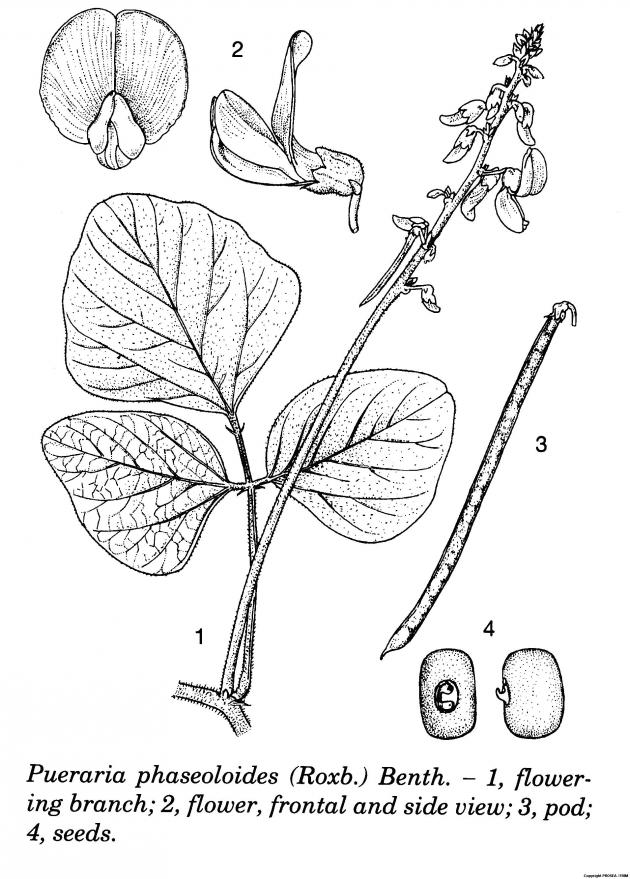Scientific Name
Pueraria phaseoloides (Roxb.) Benth.
Synonyms
Dioscorea bolojonica Blanco, Dolichos phaseoloides Roxb., Neustanthus phaseoloides Benth., Pachyrhizus teres Blanco, Phaseolus barbatus Wall., Pueraria phaseoloides var. phaseoloides. [1]
Vernacular Name
| Malaysia | Kacang hijau hutan, tampong urat [2], kacang-kacang, ulan susu, suloh [3] |
| English | Tropical kudzu, puero (Australia) [2] |
| India | Anetli, patal-kumra [4] |
| Indonesia | Kacang ruji; krandang (Javanese); fuo banga (Ternate) [2] |
| Thailand | Thua-sianpa (central) [2] |
| Laos | Pied, s’üak pied [2] |
| Myanmar | Pe ying pin [2] |
| Philippines | Singkamasaso (Tagalog); bahay (Bikol); vaay (Ivatan) [2] |
| Vietnam | D[aa]u ma, d[aa]u dai, d[aa]u r[uf]ng [2] |
| Ghana | Oye-asaasi yie [4] |
| Nepal | Ban bori [4] |
| France | Kudzu tropical, puero [2]. |
Geographical Distributions
Pueraria phaseoloides is indigenous to the lowlands of East and Southeast Asia where it occurs on river banks and roadsides, fallow fields and young secondary forests. It has been introduced into other tropical regions and is now cultivated and naturalised throughout the wet tropics. [2]
Botanical Description
P. phaseoloides is a member of the Leguminosae family. It is a deep-rooting perennial herb with climbing or twining and hairy stems. [2]
The main stems are about 6 mm in diametre and can be extended to 4.5-10 m long. It roots at the nodes if in contact with moist soil. The lateral stems branch from the nodes. [2]
The young shoots are densely covered with brown hairs. The large leaves are with three leaflets. The stipules are triangular to ovate, measuring 4-11 mm x 2-3 mm and pubescent. The hairy petiole is 3-11 cm long. The stipels are 3-7 mm long and lance-shaped to setaceous. The petiolule is 2-5 mm long. The top leaflet is symmetrical, triangular or ovate, measuring 2-20 cm x 2-16 cm, thin, with broadly wedge-shaped or subrhomboidal base and very shallowly lobed and acuminate at apex. The lateral leaflets are oblique, and measuring (4-)6-7(-14) cm x (3-)6-7(-12) cm. They are thinly hairy on the upper surface and greyish-green and densely pubescent on the lower surface. [2]
The inflorescence is an axillary, unbranched raceme, measures 10-46 cm long and pubescent. The peduncle is about 13 cm long. The bracts are 2-5 mm long and pubescent. The flowers are 10-23 mm long, mauve to deep purple and borne in pairs. The bracteoles are 1-3 mm long and lance-shaped while the pedicel is 2-6 mm long. The sepal is bell-shaped, 6 mm long, hairy, broad at the upper teeth and triangular lateral ones. The upper part of petal is orbicular, 1-2.5 cm in diametre and spurred. It is greenish on outside and white on the inner side with a mauve violet central blotch. There are 10 diadelphous stamens. [2]
The fruit is a straight or slightly curved, cylindrical or compressed cylindrical pod, measuring 4-12.5 cm x 3-5 mm, thinly clothed with stiff appressed hairs and black when mature. It is 10-20-seeded. The seed is cylindrical to cubic with rounded corners, measuring about 3 mm x 2 mm, and brown to brownish-black. [2]
The roots are subtuberous. [2]
Cultivation
P. phaseoloides is best suited to the humid lowland tropics up to 1000 m altitude with an annual rainfall in excess of 1500 mm. In an experiment under controlled conditions, an optimum temperature of 32/24°C (day/night) was found and dry matter yields were reduced by 35% with a change in temperature regime to 26/15°C. Few reports are available on photoperiod responses. In Puerto Rico (latitude 15ºN), flowering and seed set occur in the short day length period from January to March, suggesting that it may be a short day plant. In Papua New Guinea and Africa, it only sets seed under dry conditions. [2]
In comparison with other legume species, P. phaseoloideshas been ranked highly as a shade-tolerant plant. When grown under 50% shade in coconut plantations in the Solomon Islands, it was the most productive legume and it even suppressed the accompanying grasses. This characteristic makes it suitable in integrated livestock/plantation production systems. Under a regime of more than 50% shade, P. phaseoloides is still comparatively productive, but in mixtures it gives way to other species like centro (Centrosema pubescens) or desmodium (Desmodium heterocarpon (L.) DC. subsp. ovalifolium (Prain) Ohashi). P. phaseoloides is tolerant of very wet and waterlogged sites. It prefers heavy soils and is well-adapted to acid soils. It is particularly susceptible to Mg and S deficiencies and has moderate to low Ca and P requirements, but it responds to fertiliser application. On poor oxisols and ultisols, P. phaseoloides also requires Potassium (K) and Magnesium (Mg) fertiliser. It is not tolerant of salinity. [2]
Chemical Constituent
No documentation
Plant Part Used
No documentation
Traditional Use
No documentation
Preclinical Data
No documentation
Clinical Data
No documentation
Poisonous Management
No documentation
Line Drawing

References
- The Plant List. Ver 1.1. Pueraria phaseoloides (Roxb.) Benth. [homepage on the Internet]. c203. [updated on 2010 Jul 14; cited 2015 Jul 31]. Available from: http://www.theplantlist.org/tpl1.1/record/ild-2986
- Halim RA., 1997. Pueraria phaseoloides (Roxb.) Benth. In: Faridah Hanum, I & van der Maesen, LJG, editors. Plant Resources of South-East Asia No. 11: Auxiliary plants. Leiden, Netherlands: Backhuys Publisher, 1997; p. 217-220
- Herbal Medicine Research Centre, Institute for Medical Research.Compendium of medicinal plants used in Malaysia, Volume 2. Kuala Lumpur: HMRC IMR; 2002. p. 270
- Quattrocchi U. CRC world dictionary of medicinal and poisonous plants Common names, scientific names, eponyms, synonyms and etymology; Volume IV M-Q. Boca Raton, Florida: CRC Press; 2012. p.779.


